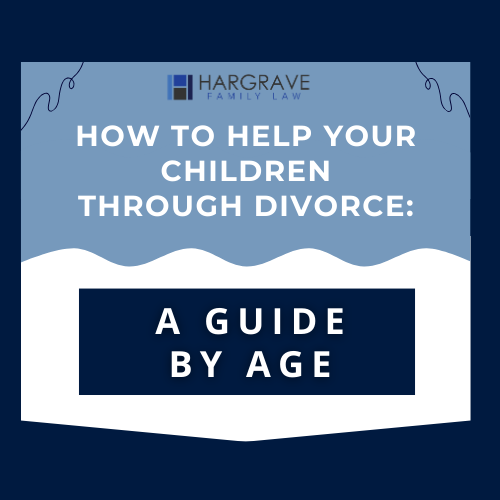Undoubtedly, divorce has a profound effect on a child’s sense of stability and emotional well-being. Numerous parents are dedicated to navigating the divorce process in a manner that mitigates any adverse impacts on their children’s lives. Child support is meant to be one of the ways that relief can be provided to both the main custodial parent and to the children involved.
No matter the age of the child at the time of the parents’ divorce, planning around child support and child custody is not easy.
Having a general guide on some of the most pressing questions that can arise during the divorce proceedings is helpful in countless ways. It can help alleviate tense moments when doubt arises about what support can and cannot cover. And, importantly for your wallet, having a clear understanding of the laws, can save you time and money.
Jennifer Hargrave, and the Hargrave Law Firm, have strived for years to provide families in the Dallas – Fort Worth Area with accessible family law resources. Jennifer is a board certified family law and collaborative law attorney with decades of experience in Divorce and Child Support.
-
Basic Child Support Definitions
-
How is Child Support Calculated?
-
Is there a ‘Maximum’ amount of Child Support?
-
Is there a ‘Minimum’ amount of Child Support?
-
High Income Earners and Child Support Orders
-
Parenting Time and Child Support
-
Is there Retroactive Child Support in Texas?
-
How can I change a Child Support Order?
-
Child Support FAQ
Understanding the Texas Child Support System and Basic Definitions
First, the Texas Family Code provides the guidelines by which child support will be calculated. These guidelines apply in most cases – especially most cases where the judge is making the decision. Parents may agree to child support that varies from these guidelines for a variety of reasons – but it’s good to know how the court will calculate child support so that you know what you are giving up if you agree to pay more, or what you are actually getting if you are getting more.
When it comes to child support in Texas, you also need to know that child support is not a “contractual obligation.” It is a legal obligation, which means it involves the party paying child support, the party receiving child support AND the State.
That’s right – the State of Texas has a vested interest in making sure that children in the State of Texas are being provided for at the minimum level required by law. The State of Texas through the Office of the Attorney General also has responsibility in administering the child support system. Child support payments are paid through the State Disbursement Unit, which then disburses the payments to the parent receiving support.
Here are some terms that are important to understand when it comes to the child support system:
Obligor – this is the parent ordered to make child support payments. This parent may also be referred to as the “non-custodial parent.”
Obligee – this is the party (doesn’t have to be a parent) receiving child support payments under a court order. This party may also be referred to as the Custodial Parent.
Child Support Order – this is the court order directing a parent to make child support payments for the benefit of the child. The child support order may be a stand alone order, or it may be part of a Final Decree of Divorce, Order in a Suit Affecting the Parent-Child Relationship, or a Modification Order.
Withholding Order – this is the Order that the Court will sign directing the employer of the Obligor to withhold wages to satisfy the child support obligation, and remit the child support payments directly to the State Disbursement Unit for processing. Withholding Orders should be signed any time the court issues an order regarding child support, though sometimes the parties will agree to suspend the automatic withholding.
State Disbursement Unit – this is the division within the Office of the Attorney General (OAG) responsible for collecting and disbursing child support payments. As part of their responsibilities, the OAG will keep a financial record showing the payments collected and the payments disbursed.
Title IV-D Courts – Title IV-D is a federal law that requires every state to manage a program for child support enforcement. The Child Support Division of the Office of the Attorney General is the official “Title IV-D agency” in Texas. Under Title IV-D, associate courts also known as Child Support Courts have been created with judges dedicated to ruling on limited issues. The limited issues the court can decide are: 1) paternity related issues (i.e., who is the child’s legal father); 2) whether a parent should go to jail or face other penalties for not paying court-ordered child support; 3) whether child support should be modified; and also 4) whether possession and access order should be established.
Private Action – Parties have the option to bring a private action with their own attorneys. Or they can apply directly through the OAG for services. Through the OAG, they can get an enforceable child support order in place. However, many people (especially in divorce situations) elect to bring a private action to better address their unique situation.
How Much is Child Support? Texas Guidelines and Calculations:
First, it is important to know that in most cases in Texas, child support is calculated using the guidelines set forth in the Texas Family Code. While parties may agree to an amount that varies from the “guideline child support” amount, Texas courts rarely order child support that varies from these guidelines.
Guideline child support in Texas is calculated based on the ‘net resources’ of the non-custodial parent. Typically, the Obligor of child support will be the parent with whom the children spend less time, and the Obligee of child support will be the parent who has the exclusive right to designate the primary residence of the children.
Once it has been determined who will be paying child support, the next step is to look at the income of the Obligor. The child support obligation is determined using a calculation that first looks at the non-custodial parent’s monthly net resources.
Net resources is a defined term in the Texas Family Code that starts with the total amount of earnings minus allowed withholdings (e.g., federal income tax withholdings, social security withholdings, self-employment taxes, union fees and the costs of the children’s health insurance premiums). Total earnings will include the income reported on a W-2 or 1099 from all sources, including any side jobs. Total earnings will also include variable income, such as bonus income and commissions. Optional withholdings (such as retirement, life insurance and other benefits) are not deducted from the total income.
So even if these amounts are withheld on the Obligor’s paycheck, they will not reduce the amount of “net income” used in the child support calculation.
Once the net resources of the non-custodial parent is calculated, the next step is to apply a percentage based on the number of children before the court in this current action. If the parent has other children to support, then the percentage will be reduced.
Child Support Guidelines Based on Monthly Net Resources of the Obligor
| Number of Children | Obligor’s Net Resources |
| 1 | 20% of Obligor’s Net Resources |
| 2 | 25% of Obligor’s Net Resources |
| 3 | 30% of Obligor’s Net Resources |
| 4 | 35% of Obligor’s Net Resources |
| 5+ | 40% of Obligor’s Net Resources |
Multiple Family Adjusted Guidelines (% of Net Resources)
| Number of Children before the Court | |||||||
| # of Children Obligor Supports | 1 | 2 | 3 | 4 | 5 | ||
| 0 | 20 | 25 | 30 | 35 | 40 | ||
| 1 | 17.5 | 22.50 | 27.38 | 32.20 | 37.33 | ||
| 2 | 16 | 20.63 | 25.20 | 30.33 | 35.43 | ||
| 3 | 14.75 | 19.00 | 24.00 | 29.00 | 34.00 | ||
| 4 | 13.6 | 18.33 | 23.14 | 28.00 | 32.89 | ||
| 5 | 13.33 | 17.86 | 22.50 | 27.22 | 32.00 | ||
What is the Maximum Child Support in Texas?
In most cases, there is a cap in Texas on the percentage of income that applies towards child support. As of 2023, net monthly income above $9,200 does not count towards child support obligations. So, if your net income is equal to or greater than $9,200/month, then you can be expected to pay 20% (or $1,840) per month on child support for one child, 25% (or $2,300) per month for two children, or 30% ($2,760) per month for three children.. Of course, this is a cap on what the court can order and enforce. Parents often agree to child support that varies from the guideline amount, but when doing so it is important to understand that the court is limited on the enforcement remedies available when the amount of child support exceeds the amount that the court could order under the Texas child support guidelines.
Is there minimum Child Support in Texas?
Texas does not have a set monthly child support minimum amount. The court ordered child support obligation depends on the income of the non-custodial parent and individual factors of each case. At a minimum, we would expect child support to at least be based on minimum wage. However, if a parent has advanced degrees and experience earning more, then the court may use additional data regarding work history in calculating the amount of child support. For low income situations where a parent is earning less than $1000 per month, there is a separate percentage calculation that starts at 15% (instead of 20%).
How are “net resources” determined in the Texas child support calculation?
All income generated is taken into consideration when calculating child support. What does this include?
Salaries and Wages:
This includes income received in the form of a salaried or contract work. It also includes income derived from commissions, overtime pay, tips, bonuses, and profit-sharing.
Investment Income:
Income generated from sources like investment accounts. It includes income derived from dividends and interest.
Retirement Benefits:
If a parent has retired and is receiving benefits, then retirement benefits and accounts are also taken into consideration when calculating net income. This includes pensions and annuities.
Other Sources:
Royalties, real estate income like property rentals and real estate sales, unemployment benefits, and other sources can also be considered.
Can the Court Order Child Support Above Guidelines?
Child support in accordance with the percentage guidelines set forth in the Texas Family Code is the rule for most situations in Texas courts. Historically, it has been very difficult for the custodial parent to get more than the percentage published in the Texas Family Code. However, Texas law does provide that the amount of child support ordered can vary from the guideline when the circumstances justify the amount. So, if you have two children and 25% of the obligor’s net income isn’t going to cut it, how do you get more child support?
The Texas Family Code provides that the court may order periodic child support payments in an amount other than that established by the guidelines if the evidence rebuts the presumption that the application of the guidelines is in the best interest of the child and the circumstances justify a variance from the guidelines. Further, the Texas Family Code has specified that in making its determination, the Court should consider the factors including the following:
- The age and needs of the child;
- The ability of the parents to contribute to the support of the child;
- The financial resources available for the support of the child;
- The amount of time of possession of and access to the child;
- The amount of the obligee’s net resources, including the income earning potential of the obligee;
- Childcare expenses incurred to maintain employment;
- Whether either party has managing conservatorship or actual possession of another child;
- The amount of spousal maintenance being paid or received by a party;
- The expenses of a child for education beyond high school;
- Benefits provided to either party by an employer, another person (e.g., spouse), or a business entity. These types of benefits might include car, housing, insurance, etc.
- Provision for health care insurance and payment of uninsured medical expenses;
- Special or extraordinary educational, health care or other expenses of the parties or of the child;
- Cost of travel in order to exercise possession of and access to the child.
This is not an exhaustive list of the “factors” the court can take into consideration, but it does provide important guidance as to when the court will consider a higher percentage.
High Income Earners (earning more than $9200/month)
What happens when the Obligor earns more than $9200 per month in net resources? The Texas Family Code makes it clear that applying the guideline percentage to this amount is presumed to be in the best interest of the child. If you want the court to order more child support, you have to prove that the child’s needs exceed this amount. What are the proven needs of the child? Well, in Texas, the court is not allowed to take into consideration the “lifestyle” expenses of the child. What is not clear is what will constitute “proven needs” of the child.
If you believe that your child’s needs will exceed the amount of guideline child support, then you need to itemize those expenses with receipts and documents to support the expenses. Here are some expenses to consider when putting together the “proven needs” of the child:
- Housing expenses (rent, utilities)
- Transportation expenses (car and gas to transport child)
- Childcare expenses, including after school care and summer camps
- Gifts for friends, teachers, coaches
- Extracurricular expenses, including travel expenses for select teams, summer sleep away camps, private coaching or lessons
- Educational expenses, such as private school if required due to child’s educational needs, tutoring, test preparation, psychoeducational testing
- Unreimbursed medical expenses, such as counseling, orthodontics, therapies
When making the list of “child-related expenses,” it is important to be mindful of what the judge in the court to which you have been assigned will be consider as “lifestyle” expenses. Private school, for example, is often not a necessity when the public schools are required to meet the special needs of the child.
The bottom line is that in Texas, getting a court to order child support above guidelines is challenging. However, there are reasons why parents enter into agreements for child support above what a court will order. Mainly, parents don’t want their children to pay the price for the separation of the parents, and want to ensure that their children can continue to receive the benefit of the “lifestyle” choices they made together during the marriage, such as a private school education.
Overall, the method for determining child support is arbitrary. If you went to a different state, you would find a different system. However, this is the “child support system” in Texas. If you want a system that considers first your shared goals and interests for your children, then looking at a process like the Collaborative Divorce process may be a better process for discussing how the children’s expenses will be paid in a post-separation/divorce reality.
Are the Rules Different if We Have Equal Parenting Time?
Having a fifty-fifty possession schedule where you share equal time with your children does not necessarily mean that you will not be paying child support. Unfortunately, our Texas Family Code does not address how child support should be determined in these situations. Here are a variety of ways child support is addressed when the parents have the children an equal amount of time:
Guideline Offset Method
Calculate the amount of child support each parent would be paying under the Texas guidelines, and then offset that amount. For example, if Mother would be paying $1520 in child support and Father would be paying $910 in child support, then Mother would pay Father the difference of $610 per month.
Above Guideline Offset Method
If at least one parent is a high income earner, then sometimes parents agree to apply the guideline percentage to the total amount of income earned by each parent, and offset the amounts. For example, say Parent 1 earns $20,000 per month, and Parent 2 earns $10,000 per month. For two children Parent 1 would pay 25% at $5000 per month, and Parent 2 would pay $2500 per month. If you offset these amounts, Parent 1 would pay Parent 2 $2500 per month.
Direct Pay of Children’s Expenses
The parents may agree that instead of monthly child support, they will each pay a proportionate share of the child’s expenses. That share may be based on the parent’s income (so if Father is earning 60% and Mother is earning 40%, then Father pays 60% and Mother pays 40% of the shared expenses). If this is something both parents are interested in considering, then the parents will do well to: 1) make sure the “shared expenses” are well defined in the Order, and 2) come up with a system for truing up the expenses on a monthly or quarterly basis.
Each Pays Own Expenses
When the parents earn relatively the same amount, they sometimes agree that each parent will be responsible for his or her own expenses when the children are in their care. This is by far the easiest, and will require the least amount of interaction between the parents. They can still agree to share in big expenses – such as summer camp or extracurricular activities. Parents can always agree to do more.
If you are considering sharing time with your children equally between both parents, then you need to know that there is not a clearly defined method of determining how much child support will be owed.
Does Texas have retroactive child support?
What is retroactive child support?
Retroactive child support refers to when a parent seeks a child support order for a period preceding the child support order being made.
The court may order a parent to pay retroactive child support if the parent has not previously been ordered to pay child support, and was not a party to a suit in which support was ordered. Even if there was a prior order, the court can still order retroactive child support if that prior order terminated (e.g., if the parties started living together or got remarried), and no support was paid during their separation.
Sometimes, people mistakenly think that they had an “agreement” in place to not pay child support. However, such an agreement is not binding on the court. So, even if your ex has told you that she won’t come after you for child support, you are not off the hook. The court and/or the Attorney General can still come after you for retroactive child support.
What’s the difference between retroactive child support and back child support?
Back child support is what some folks refer to when talking about a child support obligation that has been ordered by the court but has not been paid. If you are a non-custodial parent with a court-ordered support obligation, you should not stop paying child support. Why? Because, failing to pay child support can result in serious consequences, including the addition of penalties and interest, jail-time for non compliance, license suspension, etc. The state takes the payment of child support very seriously. Even if your ex isn’t coming after you for child support, the Attorney General can sue you for child support, and seek contempt (e.g., jail time) among all the other remedies available to the state.
Of course no one wants this. So what do you do if your circumstances have changed (e.g., you’ve lost your job, your income has decreased, or you end up having the child living with you)? You need to file to modify the Child Support Order.
How to modify Child Support Orders in Texas:
As we mentioned in this guide, the court has the ultimate authority in creating or changing a support order.
The amount that is paid to the custodial parent can be changed, but it requires a few steps. It also requires certain situations. One important thing to keep in mind is that if you and the other parent agree to change the amount of child support, that agreement needs to be set forth in an Order modifying the child support obligation. Otherwise, the obligation will continue, and the fact that you all agreed at one time to a modification will not be binding on the court, and will not protect the Obligor from being in violation of the original Order. If you reach an agreement with the other parent, get that agreement in writing in the form of an Order that is signed by the judge.
Material & Substantial Change in Circumstances
This is one of the main reasons that parents seek to modify payments. If either parent’s income changes substantially then a review of the original support order can be requested. Other circumstances include: a sudden illness, disability of a parent or a child, a change in custody arrangements, a change in living situations. Also, the legislature changes the amount of the cap every few years, so that can result in an increase in child support as well (in recent years, the cap has gone from $7500 to $8550 to $9200).
What is the Three-Year Rule?
Child Support obligations can be reviewed every three years even if there is no major change in either parent’s employment, income, or circumstances. This review can be initiated by either party in a private action, or through the Office of the Attorney General. Whether private or through the state, the Office of the Attorney General will calculate child support, and if the amount has changed by $100, then either party may request that court modify the amount of support.
Can Child Support change if there’s been a change in custody?
Yes, if there’s been a change in the custody arrangement, then child support can be reviewed and modified if necessary. There are many reasons that the child custody arrangement can change. If a child ends up living with the other parent most of the time, then that might be a reason to revisit the child support obligation.
Does child support include college?
In Texas, child support ends at the time the child turns eighteen or graduates high school (whichever occurs later). While other states do address the expenses of the child beyond high school, Texas does not. Some parents do agree to provide a means of support for children beyond high school, but those provisions will be “contractual” in nature and are not treated as “child support.”
Child Support and Taxes
Divorce can be considered a financial transition. There are a lot of emotional components and parental components in a divorce. There’s also a learning period, both during and after the separation. This learning period includes potential changes in your habits, it includes building a relationship with your children and yourself. And, this period involves a financial transition that involves everything from your bank accounts, your estate planning documents, and your taxes.
Dealing with a divorce and then dealing with the aftermath of a divorce is not easy. Things like custody, support, and property division can feel as cumbersome as hauling around a bunch of heavy boxes. But, that’s temporary. To make the most of the situation and grow for the benefit of yourself and your family, you need to be aware of what changes you need to make financially.
After a divorce, who claims a child on their taxes?
The ability to claim a child on a tax return is governed by Federal tax law – it is not governed by the Texas Family Code. Because of this, it is not necessary to address who has the right to claim the child on the tax return in the Texas order. Generally, the Federal Tax Code provides that the advises that the parent who has primary custody (i.e. the custodial parent) will have the right to claim their child or children on their tax return.
However, there are exceptions to this general rule when the parents are willing to agree to claim the children separate from the tax code. In most cases, claiming a child as a dependent on a tax return is beneficial because it can lower your overall tax burden. But, what happens if the parent with primary custody has little taxable income? What about a parent who has agreed to provide a measure of support beyond basic child support? Or what if there is not a “custodial parent” because the child is spending equal time with both parents? In these type of circumstances, it is not unusual for the parents to enter into agreements regarding which parent has the right to claim the child(ren). Sometimes, parents agree that each parent will take at least one child, or the parents agree to alternate the right to claim the child in even/odd years. These are the kind of details can be discussed when negotiating the divorce or final child support order. In the absence of an agreement, the parties will be bound by the IRS rules and regulations, which may or may not be beneficial to you in your unique situation.
Regardless, one thing is clear: both parents cannot claim the the same child(ren) on their respective tax forms.
Are child support payments taxable?
No – child support payments do not create a taxable event under the current tax system. This means that the parent making the child support payments does not get to deduct the payments from their income, and the parent receiving the child support payments does not pay taxes on those payments received.
Child Support FAQ
Q: What percent of income does a parent need to pay their ex in child support in Texas?
The standard guidelines in Texas call for the non-custodial parent to pay 20% of their net income towards child support. 5% is added for every child. So, if there are 2 children, then that would be 25%. This amount will vary slightly if the obligor (the parent paying support) also has other children to support.
Q: What factors go into determining child support in Texas?
Texas family law calls for child support to be calculated based on the number of children in the marriage, the net income of the paying parent, and the number of other children that parent is legally obligated to support.
Q: Can you appeal a child support order?
Yes, Texas allows for child support orders to be appealed. When a child support order has been rendered by an Associate Judge or Title IV Judge, a party can file a ‘de novo’ hearing within three (3) days of the judge’s ruling Your de novo hearing will occur within 30 days from the date of your request submission. If the District Judge made the ruling as part of the final order (Decree or Order), then the ruling can be appealed to the Appellate Courts.
Q: What factors are considered when modifying child support?
To modify a child support order you must show that your material circumstances have significantly changed. This might be due to a change in employment, a drop in income, and/or a medical emergency. Also, if a parent has moved outside of the geographic restriction, that can be a reason to modify support.
Q: Does child support end if the parent remarries?
If the parties to the child support order remarry each other, then yes – remarriage will terminate the child support obligation. As you can guess, that doesn’t happen all that often. However, if either of the parties marry someone else, in most cases that alone will not constitute a material and substantial change that will support a modification of child support in Texas. The spouse’s income will also not be a factor in the child support calculation.
Child Support is there to help your Children
Obligors and Obligees both usually agree on one thing – that the amount of child support is wrong. For Obligors, it’s too much money. For Obligees, it doesn’t even begin to cover the expenses of the children. While no one is happy with the system, it’s the system we have.
When it comes to child support, the best thing you can do is keep the focus on your children. At the end of the day, child support is there to help your children.
We’re more than just your attorneys
Ideally, child support is supposed to create a balanced arrangement that helps your child grow and thrive. Child-related expenses, like food, activities, doctor’s appointments, and education fluctuate depending on the age of the child. With the proper agreement, these needs and their possible fluctuations will not compromise the child’s well-being.
We know that being happy with your support order is not easy. It’s one of the many factors parent’s have to consider as they transition into their new post-divorce parenting routines. Hargrave Family Law has worked with families across the DFW Metroplex. Our offices are conveniently located in Farmers Branch, Dallas, Texas. We offer our clients peace-of-mind through excellent legal help and free family law resources on our site. Looking for legal counsel for your family law issue? Give our team a call today.































